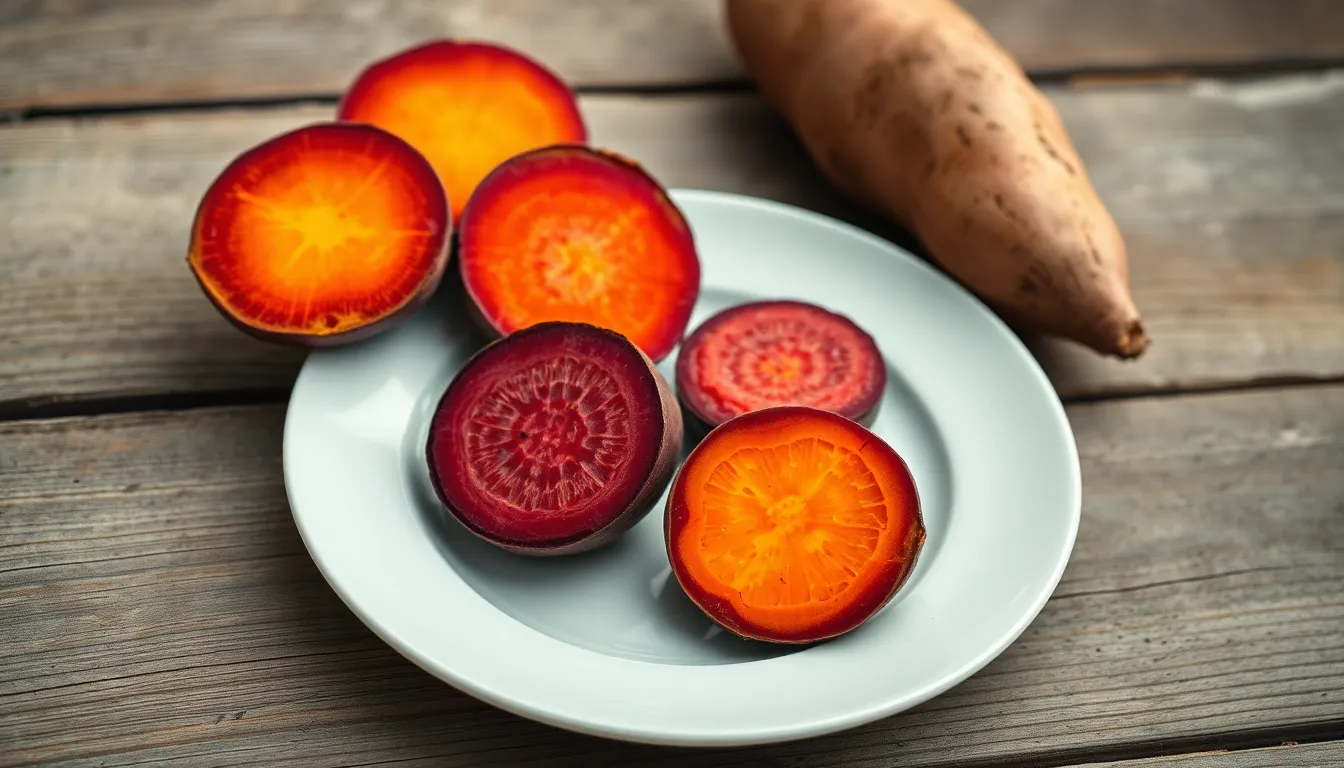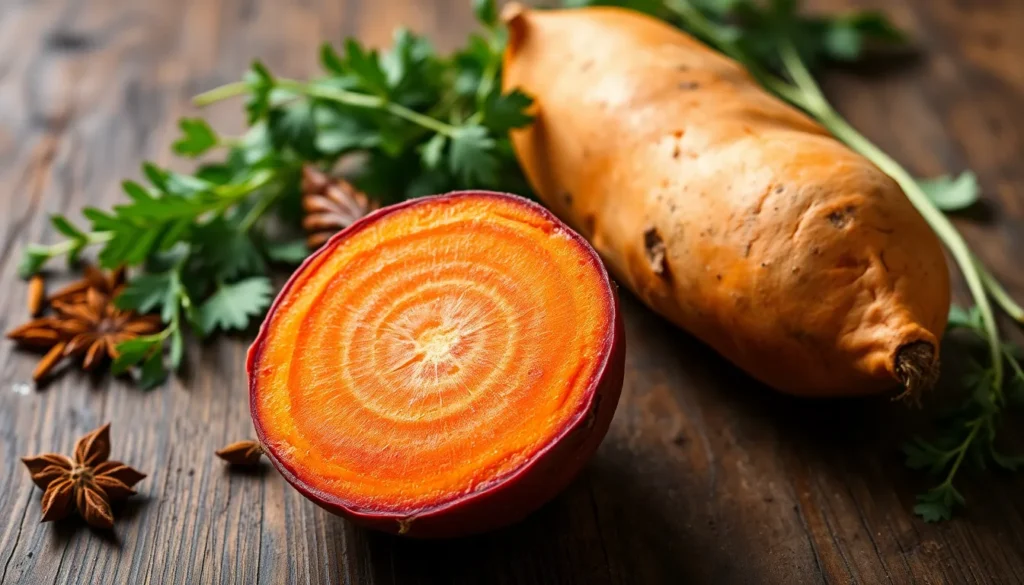Table of Contents
ToggleWhen it comes to the battle of the tubers, garnet yam and sweet potato are like the dynamic duo of the vegetable world. Both are deliciously sweet and packed with nutrients, but which one reigns supreme? Picture this: one’s a vibrant orange powerhouse, while the other sports a deep reddish-brown skin that begs to be roasted. It’s a culinary showdown that could leave your taste buds in a tizzy!
Overview of Garnet Yam and Sweet Potato
Garnet yam features a reddish-brown skin with a moist, creamy texture inside. Its flavor leans towards sweetness, making it ideal for both savory and sweet dishes. Nutritionally, it offers a rich source of vitamins A and C, potassium, and dietary fiber. This yam boasts a high antioxidant content, making it a beneficial choice for overall health.
Sweet potato, known for its vibrant orange hue, presents a similar sweet taste but with a firmer texture. This tuber is renowned for its versatility in recipes, from baking to mashing. Sweet potatoes are also rich in vitamins, particularly vitamin A, which supports eye health. They provide complex carbohydrates that offer sustained energy.
Both garnet yam and sweet potato differ in culinary applications despite their similarities. Garnet yam complements dishes with its creaminess, while sweet potato enhances recipes with its slightly denser structure. While they share a sweet flavor profile, their textures can influence cooking methods and meal planning.
Culturally, these tubers hold significance in various cuisines. Garnet yam appears prominently in Southern dishes, often found in casseroles or as a baked side. Conversely, sweet potato is common in both savory and dessert recipes worldwide.
Understanding these differences helps in choosing which tuber to incorporate in specific recipes. Both garnet yam and sweet potato offer unique attributes that can elevate culinary experiences.
Nutritional Comparison

Garnet yam and sweet potato, both nutritious options, showcase distinct vitamin and mineral profiles.
Vitamins and Minerals
Garnet yam is abundant in vitamins A and C, essential for immune function and skin health. Potassium, found in significant amounts, aids in maintaining healthy blood pressure. Sweet potato also excels in vitamin A content, which is pivotal for vision health. It contains vitamin C, B vitamins, and manganese, supporting metabolism and bone health. Both tubers supply dietary fiber, promoting digestion. Each offers antioxidants that combat oxidative stress, contributing to overall well-being.
Caloric Content
Garnet yam contains approximately 140 calories per medium serving, making it a hearty addition to meals. Sweet potato features around 112 calories per medium potato, providing a lighter option. While both are calorie-dense, garnet yam’s creamy texture contributes to its filling nature. Sweet potato’s versatility in dishes allows for varied preparation styles without greatly altering calorie counts. Both can fit into a balanced diet, catering to different caloric needs based on the chosen preparation methods.
Culinary Uses
Garnet yam and sweet potato serve versatile roles in the kitchen, enhancing a variety of dishes. Each tuber brings unique flavors and textures suited for numerous culinary applications.
Cooking Methods for Garnet Yam
Garnet yam shines in various cooking methods. Baking garnet yam produces a naturally sweet, creamy texture that complements both savory and sweet dishes. Mashing transforms it into a rich, flavorful side, easily blended with herbs or spices. Roasting elevates its natural sweetness while providing a satisfying crisp outside. Steaming preserves nutrients while softening the flesh, allowing it to pair well in salads. Casseroles featuring garnet yam provide delicious comfort food options that meld well with cheese or herbs.
Cooking Methods for Sweet Potato
Sweet potato excels in diverse cooking styles. Baking enhances its natural flavors, yielding a tender and sweet result, perfect for side dishes. Boiling sweet potato softens it for mashing or can be added to soups for heartiness. Frying or air-frying creates delightful crispy bites for snacking or appetizers. Sweet potato also works well in desserts, like pies or puddings, showcasing its sweetness. Grilling imparts a smoky flavor, ideal for salads or as a stand-alone side.
Health Benefits
Both garnet yam and sweet potato offer numerous health benefits, making them valuable additions to any diet. Each tuber provides essential nutrients that contribute to overall wellness.
Benefits of Garnet Yam
Garnet yam stands out for its high vitamin A content, promoting healthy vision and immune function. It contains significant amounts of vitamin C, which aids skin health and helps combat inflammation. Potassium in garnet yam supports blood pressure regulation, vital for heart health. Dietary fiber contributes to digestive health, promoting regularity and a feeling of fullness. Antioxidants present in garnet yam help neutralize free radicals, reducing oxidative stress, which may lower the risk of chronic diseases.
Benefits of Sweet Potato
Sweet potato excels in providing vitamin A, crucial for maintaining healthy eyesight and skin integrity. Its rich vitamin C content enhances the immune system, supporting overall health. B vitamins found in sweet potato assist in energy metabolism, making it a great choice for active individuals. Manganese present contributes to bone health and aids in wound healing. The dietary fiber in sweet potato regulates digestion, promotes satiety, and supports gut health.
Taste and Texture Differences
Garnet yam presents a moist and creamy texture, which enhances its appeal in both savory and sweet culinary creations. Similarly, sweet potato has a firmer consistency, making it ideal for a variety of cooking methods. The sweet flavor of garnet yam complements dishes like casseroles and baked goods, while sweet potato’s versatility shines in both side dishes and desserts.
In taste, garnet yam’s natural sweetness often stands out, making it a favorite in many recipes. Comparatively, sweet potato offers a unique flavor that can be further enhanced with spices or sweeteners, often used in holiday dishes and when baked. Distinct from each other, garnet yam can blend seamlessly into creamy soups, while sweet potato maintains its structure, suitable for chunky stews or when mashed.
The cooking process also affects the final texture of each tuber. Steam or roast garnet yam for a softer, smoother consistency, enhancing its creamy profile. When one bakes or fries sweet potato, it achieves a crisp exterior, adding a delightful crunch to meals. Consumers may notice that when garnet yam is pureed, it creates a rich, velvety base ideal for pies. Sweet potatoes, when baked, can develop natural caramels, enriching their already sweet flavor.
Flavor pairings further highlight their unique qualities. Garnet yam complements spices like cinnamon and nutmeg, often found in desserts. On the other hand, sweet potato works well with savory elements like garlic and rosemary, offering versatility in various cuisines. Taste and texture differences between garnet yam and sweet potato significantly influence their uses in diverse recipes, serving as an essential guide for culinary enthusiasts.
Choosing between garnet yam and sweet potato ultimately depends on personal preference and culinary needs. Each tuber offers distinct flavors and textures that can elevate various dishes. Garnet yam’s creamy consistency is perfect for those looking to add richness to meals, while sweet potato’s firmer structure provides versatility across cooking methods.
Both options are packed with nutrients that support overall health, making them excellent additions to any diet. Whether used in savory casseroles or sweet desserts, garnet yam and sweet potato can satisfy diverse palates. Embracing the unique qualities of each tuber can lead to delightful culinary experiences that celebrate their nutritional benefits and flavors.







